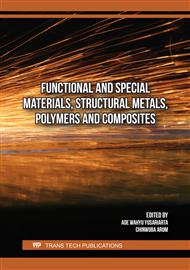[1]
Horton MJ, Schmid SR. Library of Congress Cataloging-in-Publication Data Kalpakjian, Serope, 1928-Manufacturing engineering and technology / Serope Kalpakjian. n.d.
Google Scholar
[2]
Hausnerova B, Mukund BN, Sanetrnik D. Rheological properties of gas and water atomized 17-4PH stainless steel MIM feedstocks: Effect of powder shape and size. Powder Technol 2017;312:152–8.
DOI: 10.1016/j.powtec.2017.02.023
Google Scholar
[3]
Amin SYM, Muhamad N, Jamaludin KR. Rheological properties analysis of WC-Co injection feedstock. Materials Science Forum, vol. 773–774, Trans Tech Publications Ltd; 2014, p.880–6.
DOI: 10.4028/www.scientific.net/MSF.773-774.880
Google Scholar
[4]
R. K. Gupta, "Polymer and Composite Rheology, Second Edition, Plastics Engineering," (2000)
Google Scholar
[5]
Marie-Aude Porter, Effects of Binder Systems for Metal Injection Moulding, master's thesis, Luleå University of Technology, (2003)
Google Scholar
[6]
Soo Park M, Kon Kim J, Ahn S, Jin Sung H. Water-soluble binder of cellulose acetate butyrate/poly(ethylene glycol) blend for powder injection molding. n.d.
DOI: 10.1023/a:1012579010171
Google Scholar
[7]
Askari A, Momeni V. Rheological investigation and injection optimization of Fe–2Ni–2Cu feedstock for metal injection molding process. Mater Chem Phys 2021;271.
DOI: 10.1016/j.matchemphys.2021.124926
Google Scholar
[8]
Mindivan AF. EFFECT OF CRYSTALLINE FORM (γ) OF POLYAMIDE 6 / GRAPHENE NANOPLATELETS (PA6/GN) NANOCOMPOSITES ON ITS STRUCTURAL AND THERMAL PROPERTIES. n.d.
Google Scholar
[9]
Martynková GS, Slíva A, Kratošová G, Barabaszová KČ, Študentová S, Klusák J, et al. Polyamide 12 materials study of morpho-structural changes during laser sintering of 3d printing. Polymers (Basel) 2021;13.
DOI: 10.3390/polym13050810
Google Scholar
[10]
Maron SH, Sisko AW. APPLICATION OF REE-EYRING GENERALIZED FLOW THEORY TO SUSPENSIONS OF SPHERICAL PARTICLES. H. FLOW IN LOW SHEAR REGION. vol. 12. 1957.
DOI: 10.1016/0095-8522(57)90031-4
Google Scholar
[11]
Liu ZY, Loh NH, Tor SB, Khor KA. Characterization of powder injection molding feedstock. Mater Charact 2003;49:313–20.
DOI: 10.1016/S1044-5803(02)00282-6
Google Scholar
[12]
Foong ML, Tam KC. Application of Polymer Technology to Metal Injection Molding (MIM) Processing. n.d.
DOI: 10.1016/b978-081551426-8.50012-x
Google Scholar
[13]
bin Suleiman @ Ahmad MJ, binti Abdulah N, bin Omar MA, binti Mohd Zainon N, bin Mahaidin AA, bin Nurul Hadi MA, et al. Rheological Study of a Copper Feedstock. Adv Mat Res 2016;1133:329–33.
DOI: 10.4028/www.scientific.net/amr.1133.329
Google Scholar
[14]
Thavanayagam G, Pickering KL, Swan JE, Cao P. Analysis of rheological behaviour of titanium feedstocks formulated with a water-soluble binder system for powder injection moulding. Powder Technol 2015;269:227–32.
DOI: 10.1016/j.powtec.2014.09.020
Google Scholar
[15]
Li G, Xia H, Lei Y, Yang W Bin, Liu T, He JP. Highly conductive polymer composites with excellent toughness, fluidity and temperature-independent conductivity. J Appl Polym Sci 2020;137.
DOI: 10.1002/app.48820
Google Scholar
[16]
Ferrández-Montero A, Lieblich M, Benavente R, González-Carrasco JL, Ferrari B. Study of the matrix-filler interface in PLA/Mg composites manufactured by Material Extrusion using a colloidal feedstock. Addit Manuf 2020;33.
DOI: 10.1016/j.addma.2020.101142
Google Scholar
[17]
Thalib S, Huzni S, Fonna S, Azhari CH, Zakaria S. The effect of particle compositions on the activation energy of the pa6/bagasse composite. IOP Conf Ser Mater Sci Eng, vol. 602, Institute of Physics Publishing; 2019.
DOI: 10.1088/1757-899X/602/1/012086
Google Scholar
[18]
Liu D, Chen R, Zhan K, Chen Z, Luo X. Study on wall-slipping mechanism of nano-injection polymer under the constant temperature fields. E-Polymers 2023; 23. https://doi.org/10.1515/ epoly-2023-0085.
DOI: 10.1515/epoly-2023-0085
Google Scholar
[19]
Chawla KK. Composite materials: Science and engineering, third edition. Springer New York; 2012.
DOI: 10.1007/978-0-387-74365-3
Google Scholar
[20]
Thavanayagam G, Pickering KL, Swan JE, Cao P. Analysis of rheological behaviour of titanium feedstocks formulated with a water-soluble binder system for powder injection moulding. Powder Technol 2015;269:227–32.
DOI: 10.1016/j.powtec.2014.09.020
Google Scholar
[21]
Goyal RK, Kambale KR, Nene SS, Selukar BS, Arbuj S, Mulik UP. Fabrication, thermal and electrical properties of polyphenylene sulphide/copper composites. Mater Chem Phys 2011;128:114–20.
DOI: 10.1016/j.matchemphys.2011.02.065
Google Scholar


